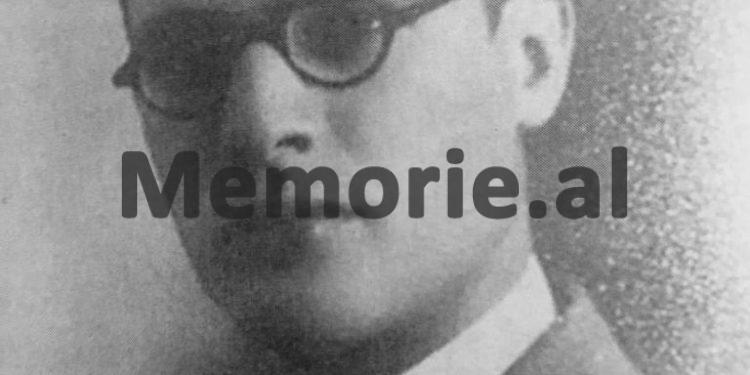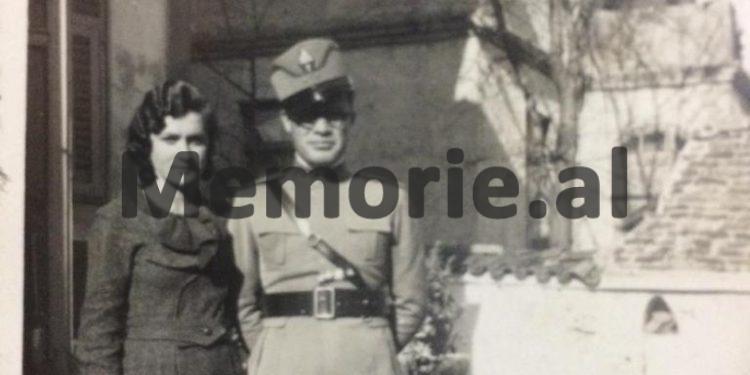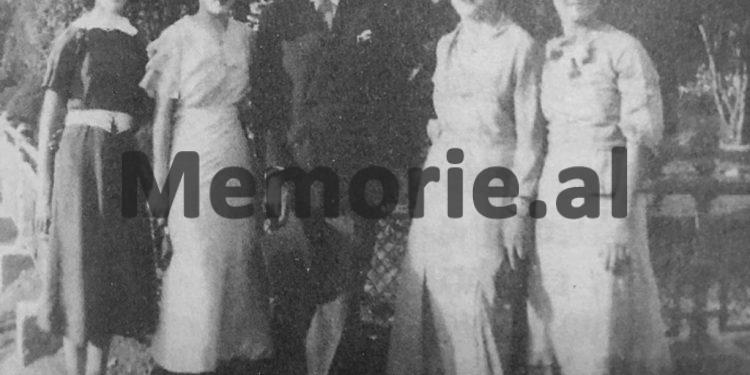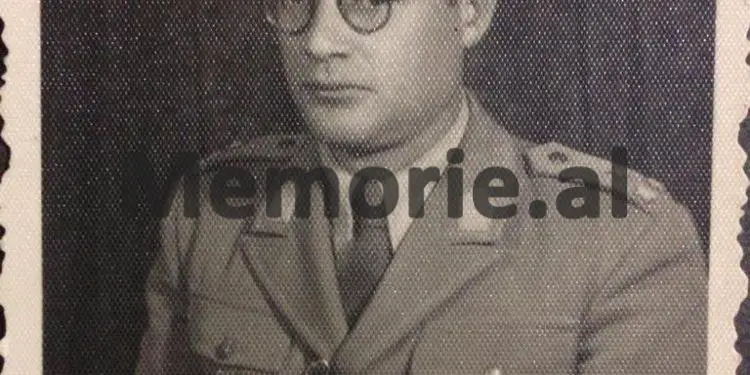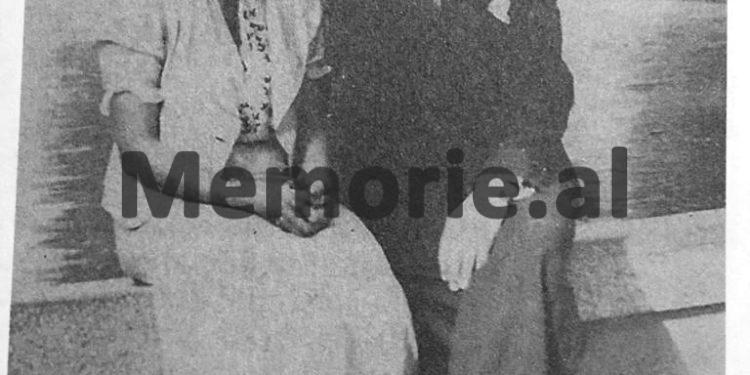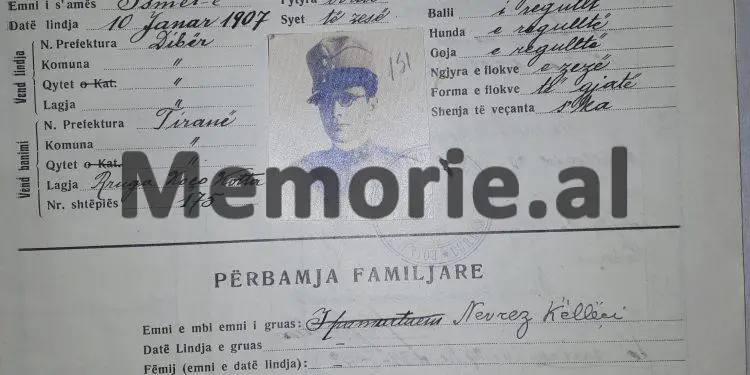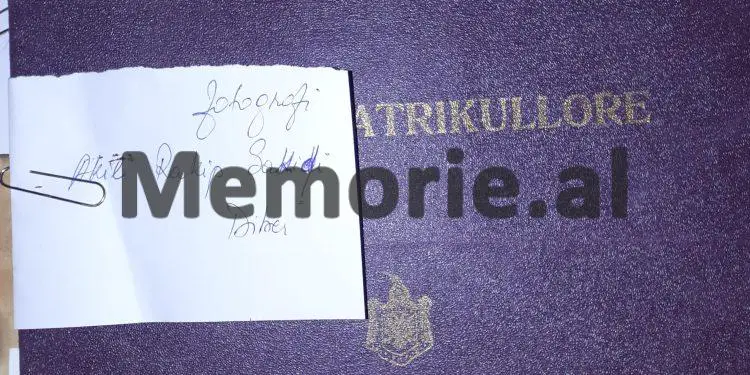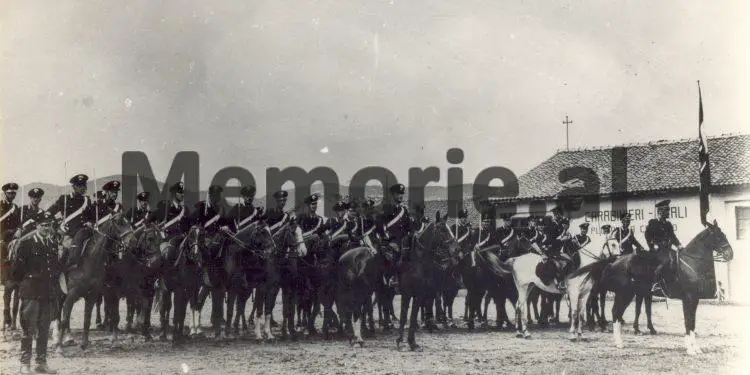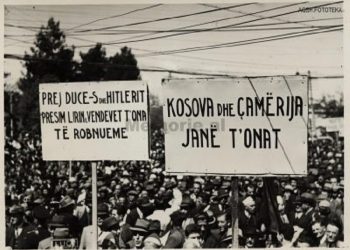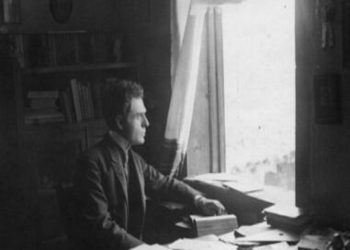Dashnor Kaloçi
Second part
Memorie.al /publishes the unknown story of Akil Sakiqi, originally from Dibra e Madhe, suckling of one of the most famous and rich families of that province, (his father, Rakipi was engaged in trade and owned about 1500 ha of land and property others in Janica near Thessaloniki), who thanks to the good economic situation of the family, after being educated in Istanbul and Ioannina, in 1923 returned to his homeland and studied at the French Lyceum of Korça, where as a classmate and dormitory room, there was also Enver Hoxha. Sakic’s military career during the period of the Zog Monarchy after he had acquired a study right from the government of that time and had graduated from the Military Academy of Rome in the branch of “Guard of Finance” where he received the rank of lieutenant, serving as an officer of the ‘Border Guard’ in the region of Shkodra, until 1938, when by royal decree he was transferred to the district of Durres, with the duty of deputy commander of the battalion, where he found and April 7, ’39, when Benito Mussolini’s fascist Italy, carried out military aggression by invading its Adriatic neighbor, King Zog’s Albania. Sakiq’s military career during the occupation of the country, where after the amnesty granted by the Italian authorities in April ’39, (for all those Albanian soldiers who had waited with guns for the occupation), serving as an officer of the Guard of the Border ”in the district of Shkodra, where he stayed until 1943 when he was appointed in Tetovo and after the capitulation of fascist Italy in September of that year, he returned to Tirana, where he lived with his family in a rented apartment in Pisha Street, until October 28, 1944, when a partisan unit took him from his house and executed him somewhere in the ‘River Bank’, together with his two friends, Nazmi Uruçi and Fahri Dabulla, the remains of whose are still not found today… ?!
On April 7, 1939, 82 years ago when Benito Mussolini’s fascist Italy carried out military aggression by invading its neighbor across the Adriatic, Albania, a large part of the Albanian military of the Zog Monarchy, such as: Colonel Sami Koka, major Abaz Kupi, Captain Kadri Rustem Bardulla, Captain Nuredin Pustina, Captain Nikoll Mëlyshi, Lieutenant Myftar Jegeni, etc., welcomed the Italian occupying forces with weapons, as in Durrës, Vlora, Shengjin, Saranda, etc., making a symbolic resistance, so as much as a small army in numbers and military equipment (such as that of the Bird Monarchy) could do to one of the greatest military powers of the time, such as the Italy of Benito Mussolini and King Victor Emmanuel III. But that resistance of those few Albanian soldiers of the Monarchy, not only was never mentioned by the official historiography and propaganda of the communist regime of Enver Hoxha, for almost 45 years in a row, but on the contrary, they were labeled as “enemies and traitors” and most of them ended up in prisons and internment camps as political prisoners. While the only military of the Monarchy that the communist regime would declare “Martyr of the Fatherland”, and would be proud of, considering it as a “symbol of the armed resistance of April 7, ’39”, was Mujo Ulqinaku, a Captain of the Guard of Finance, who lost his life during the landing of Italian fascist troops in the port of Durres, fighting against them. One of those military soldiers of the Zog Monarchy who fought on April 7, ’39 in Durrës, was Captain Akil Sakiqi, who was executed by partisan units in November 1944, before the end of the war, being an among the first victims of communist terror in the city of Tirana, along with many other intellectuals, who were taken from their homes and executed without trial, as happened with the event known after the ’90s as the “Massacre in Bristol Hotel, where the Communists executed 33 innocent intellectuals. For more about Akil Sakiqi and his entire history, we will get to know him in this article that we have prepared with testimonies of people who knew about it, such as the memories of the former soldiers of the Monarchy, colleagues of Akil Sakiqi, as Captain Nuredin Pustina, the memories of Enver Hoxha (Sakiq’s classmate and roommate at the Korça High School) from the testimonies of his family, various scholars and historians, as well as from many archival documents, which Memorie.al makes public for the first time in this writing.
Continues from the last number
“Bloody Tirana” – Communist Massacre, autumn 1944
Three high school students: Akil Sakiqi, Nazmi Uruçi, Fahri Dabulla
The monstrous crimes committed by Enver Hoxha’s communist regime immediately after he came to power in November 1944, with the murders and extrajudicial executions of tens of hundreds of innocent people, were written after the 1990s and have been widely published. archival documents that shed light on those events. One of those scholars and journalists who has dealt with those events and crimes committed by the communists since November ’44, before the end of the war, is Bedri Alimehmeti, who in his book entitled “Tirana e bloody”- The communist massacre, autumn 1944 ‘, has treated a short history of the life, career and execution of the soldier of the Zog Monarchy, Akil Sakiqi. Thus, in the chapter entitled “Three high school students: Akil Sakiqi, Nazmi Uruçi and Fahri Dabulla”, he wrote:
“Tefta Tashko Koço” is the name in Tirana of the street that leads from the square “Avni Rustemi” and continues along until near the building of the Ministry of Foreign Affairs. Years ago, it would probably be more accurate to say that at the time when the city began to grow from an urban point of view, this street was called “Pisha”, a name that we continue to hear even today. And exactly on the cobblestones of this road, in the darkness of the distant night of October 28, 1944, the heavy steps of a partisan patrol, disturbed the tranquility of that tyrannical evening, which was slowly feeling its warm wings over the city.
The residents of the terrorized street held their breath under the anxiety of waiting, where they would stop! As partisan forces approached the outskirts of the capital, the news circulating inside it was one of the most shocking. Anyway, that night, the rattling of heavy steps on the cobblestones ended in front of the gate of Ymer Dërhemi’s house, where Akil Sakiqi, an officer of the Albanian National Army, who had served at the border and in the background sector, lived for rent. Akil Sakiqi had been living in Tirana for years, while he was born in 1907 in Dibër e Madhe. His family, initially to escape the violence and reprisals of Serbian chauvinists, initially settled in Turkey. But out of great love for the land of his ancestors, his parents decided to return to Albania. Finally stabilizing in Tirana. Achilles, a smart boy eager to enrich and perfect as much knowledge as possible, after he graduated excellently from the Lyceum of Korça, graduated with very high results from the Military Academy in Rome, Italy, in the branch of ‘Finance Guard’. After that he returns to his homeland and works with dedication and devotion first in Durrës, then in Shkodra, etc. He welcomed the fascist invasion of Italy by the Duce on April 7, 1939, with deep indignation and great hatred. Even together with his friend Myftar Jegenin and other patriotic officers, they fought against the fascist aggressors. Badly disappointed, as they failed to repel the invader, he seceded from everything, not mixing at all with any political party, and eventually shut himself up in his civilian life. On the night of October 28, 1944, when the partisans armed to the teeth knocked on the house of the white-hearted tyrant Ymer Dërhemi, they had nothing to do with the owner of the house. The destination of the red demons had been Akil Sakiqi, who at that moment was having dinner with his friends, Nazmi Uruçi and Fahri Dabulla, all three career officers, classmates from the Lyceum of Korça. While they were eating, Achilles, who loved and respected the wonderful Albanian customs, invited the uninvited guests of that night to sit down and eat together at the set table. To the red demons, the greed of filling the belly was the same as the thirst to quench the lives of people. So, without the slightest hesitation, they sat down at the generous table of the Sakiqi family and ate as much as they could. The lady of the house had cooked wonderfully. Who knows how many times that noble lady cursed that moment later, when she remembered that she had laid it to eat for her husband’s murderers, those who would wear it forever in black and beat her over the years to raise orphans. ‘Haram be the bread that you and my compassionate mother. Let him be poisoned and poisoned and blackened all generation after generation, these breadwinners. After the terrorists left, the owner of the house, Ymer Dërhemi, entered the room where Akil Sakiqi was staying with his two friends, Nazmi Uruçi and Fahri Dabulla. With the sharpness that characterized him he had managed to smell something bad, he was even completely convinced that the bloodsuckers would return again, so he calmly advised them to leave temporarily. But Achilles and his comrades did not feel guilty at all, for they had done no wrong, guilt, or crime, so they decided to stay. This decision seemed even more right to him, when not only had they not done any injustice, but on the contrary they had actively helped the war. But after that, as the hands of the clock were approaching twelve, knocks were heard on the door of the house. The hyenas had returned again to plunder the prey. The smell of good old Ymer Dërhemi had been correct. After that, the partisan patrol took the three with them, as only one of them had whispered the deadly slogan through his rotten teeth: “You are wanted in command for an explanation”. And it was the same people who, just a few hours earlier, had risen from the table of that generously and heartfelt house. Behind the curtain of the sad window at the roof, hoping to return soon, the lady of the house followed her husband with anxious eyes, together with his two companions, until the darkness of night engulfed them, further down the road that hung along the shore. of Lana, to the mill, without knowing it and without even thinking, that this was the last time she saw him. There, waiting with their foreheads resting on the cold glass, they found the first rays of the sun, which shone like fear over Dajt. And Akil Sakiqi and his two high school friends, Nazmi Uruçi and Fahri Dabulla, never returned. They were shot that night on November 28, 1944. Like Akil Sakiqi and Nazmi Uruçi, he was from Dibra e Madhe. They had studied together at the Lyceum of Korça. Fahri Dabulla had also been a high school student in Korça. Enver Hoxha had known all three as excellent students in lessons, as ardent patriots and as respected, honest and correct people. It was precisely for these qualities, which he pathologically hated, that he blacklisted them for death.
Archival documents prove that the execution of the military and Akil Sakic was ordered by Enver Hoxha
Regarding the events of November 1944, when the War in Tirana was not over, many innocent intellectuals were executed without trial, forcibly taken from their homes (mainly former soldiers of the Zog Monarchy and the Albanian National Army). who had served in various positions during the occupation period, 1939-1944), such as the event of the Hotel “Bristol” in the center of the capital, where 33 innocent intellectuals were shot, has been widely spoken and written after the ’90s , where various researchers and historians have published archival documents which shed light on the role of Enver Hoxha as the mastermind of those murders that took place in Tirana at that time. Thus, in a publication of the General Directorate of Archives of the Albanian State, entitled “Second Plenum of the Central Committee of the Albanian Communist Party”, a document is published, which contains the conversations of Gogo Nushi (then Political Secretary of the Communist Circle of Tirana ) with Krsito Themoleko (one of the main leaders of the SNP since the founding meeting of November 8, 1944), held during a meeting, where Gogo Nushi expressed his concern to Themelko, saying: “With the entry of our forces in Tirana, about 60 people were killed. “I know most of them and no one deserved to be shot.” Themelko replied: “When I talked to Enver, he ordered me to clean the dangerous elements when you enter Tirana.” The well-known politician and historian, Uran Butka, has long written about the above in his study books, shedding light on archival documents on the role of Enver Hoxha as the mastermind of communist terror in Tirana, in the period October-November 1944. where dozens of innocent people and intellectuals were executed, one of whom was the nationalist military man, Akil Sakiqi.
General Dali Ndreu’s telegram for the capture of Captain Akil Sakiqi
Regarding the order given by the highest leaders of the Albanian Communist Party for the arrest of Captain Akil Sakiqi, there is also an archival document which contains a thick notebook, where are the orders given by the Command of the First Corps of The National Liberation Army, commanded by Major General Dali Ndreu, who took part in the fighting for the liberation of Tirana, which states:
Nr. 173, gr. 37, 15 / 12.’44
Corps II
Let us know if you are in Division 6, Captain of Finance, Akil Sakiqi, Captain of Finance, Fahri Dabulla and Captain of Xhenjo, Rakip Kalenja. Let us know if Galip Mati has started.
Dali
Enver’s memories of the execution of the military in Tirana in November ’44
But regarding the events that took place in Tirana in the period October-November 1944, Enver Hoxha also stopped and wrote at length in his memoirs published in the early 80’s (the book “When the foundations were laid”), where among other things he recalls:
Shortly before the plenum of Berat, Sejfulla Malëshova came to me with all the “alarm”.
“There’s a lot of terror going on,” he tells me angrily.
– Terror? – I asked surprised. – Where?
– In Tirana, – he answers me. – many repentant officers are being killed.
“The great struggle for the liberation of the capital continues in Tirana,” I told him. – Who do you call terror? And which officers are you complaining about”?!
The terror exercised by the partisan units upon their entry into Tirana from the end of October 1944 until the end of the War, among others, was discussed in the Berat Llenum (November 24-27, 1944), where in front of the Yugoslav Communist Party envoy, Colonel Velimir Stoinic, Enver Hoxha himself admitted everything that had happened there, saying: “Dozens of people and second-hand officers are being killed in Tirana, who, having full faith in justice and in our proclamation, surrender. Such work is not casual, but it is the whole tone given to the organizational work of the party and the army. “Our comrades only intend to annihilate anyone who is not with us, who does not think like us, to annihilate even ordinary people.”
Orhan Sakiqi: In search of the father’s bones!
Regarding the life story of Akil Sakiqi, former soldier of the Zog Monarchy and the Albanian National Army in the period of occupation 1939-1944, his son, Ing. Orhan Sakiqi, a well-known figure in the political and social life of Tirana after the ’90s, who is also the author of several books on various topics that he published after the’ 90s. In one of his last books entitled, “Chronicle of lost lives”, (M & B Publications, Tirana 2019), in the chapter entitled, ‘In search of the bones of the father’ he wrote:
“Is our father alive or dead?! This suspicion has haunted me since childhood. By the age of 7-8 I had a suspicion that my mother was saying: ‘Until the body is found and the authorities confirm his murder, he may be alive somewhere outside’.
I told him:
– ‘Well, why not give signs or send a letter?!
– ‘But maybe he is afraid of them.
– ‘Yes, who are these?
They are curious questions that make children want to know more about what they do not understand.
These, was an expression I had often heard in the conversations of adults at home, but now., Maybe I wanted to understand the word. These are the communists, it is the government, who have never admitted the crime. Some people thought to be dead are turning out to be alive lately, so let’s not lose hope. Until then I had understood the government as a tall building, I even imagined it as if it were the former gymnasium of Tirana, a tall building, the former Turkish barracks, located behind the Cafe “Kursal”, or better for orientation today, close to the National Bank. Now I realized that the government is the people and not the buildings.
It was 1946 and the mother was hoping. I hoped so too, after that. I remember my grandfather holding me in his arms, I remember how I struggled to get rid of his gizzards. I remember bending over to listen to the radio. How is it possible to eliminate the babush?! Even today, whenever I see the radio, (which I guard carefully), my mind goes to it. The sister who was 2 years old, remembers nothing. Better that way, maybe. Unpleasant memories make you see the world with a different eye.
They say orphans mature faster than those who have parents. This is true. By this time, I had ceased to be a child. For years, as I plunged deeper and deeper into my contemplations, my mind was filled with accepting the truth without having the strength to oppose it. But as Ernesto Sabato says in his book The Tunnel, “I am convinced that there is a single, dark, solitary tunnel.” Maybe this was the tunnel through which my childhood, my youth, my whole life had flowed, it was this dark tunnel of my father’s disappearance. Many times, I tried to get out of the tunnel, but there were always people who mentioned him not in the eyes, but behind the wings. “He has a place in the tunnel.” This is what the so-called communist gods decided.
Over the years, it became clear that my father, along with about 100 citizens, had been killed without trial in the ‘Tirana Massacre’, from October 28, to November 16, 1944. At that time, my mother was obsessed with finding the bones. Such an undertaking was not easy. Those who had committed the crime, of course, were hiding, someone else who had some knowledge even heard, was afraid not only to give an answer to what he knew, but also refused to open his mouth.
However, my mother later told me that with the help of a relative, she had been able to locate them at a burial site somewhere outside the United School, but that construction had already taken place there and the traces had disappeared.
But she was not convinced of that place. He insisted on the ‘River Bank’. “They took them there,” he said. That was the place of most of the people shot in Tirana, like the work of the cherry blossom in Burrel Prison. But where is the river bank of Tirana long?! Where to look for it and where to find it?! Then the river is full in winter, there are numerous streams that cover the shores and take everything with them. Then surely, they were buried shallow. I thought these things, but I did not tell my mother.
My mother left this world with this hostage in her heart, but it turned out that she was right about the ‘River Bank’, which was confirmed to me by the late Islam Zekthi in 1993. “I was also arrested on October 28, 1944, as a twenty-year-old who I was active with the ‘National Ball’. They tied us to each other with ropes as if we were cattle and sent us to Tufina. Starting on the hill, late at night we hear some batteries of shots. We did not need to ask because the escorts explained it to us. “Stay calm, because you will suffer the same way.” The place was at the ‘River Bank’, not far from the ‘Kendi’ Hotel. After they took us to the village of Shupal, or Zall-Dajt, they locked us in a cot and we stayed there until November 17th. Then I ended up in ‘Tirana Prison’, where I was sentenced to 15 years. After I got out of prison, I worked as a transport worker. We loaded gravel and sand into the Tirana River. I will never forget the day my shovel struck human remains. And it was right down the hill of Tufina…! I went with Islaim instead and put a bouquet of flowers. “If not for my father, it will be for someone else.”
The mother was always puzzled. It seemed to him that we had not done enough to find the bones, especially after 1992.
We have a consolation. We are not alone. There are about 6,000 people shot by communism. 2500 have been found, so there are 4000 left. Little is being done for their search, when it seems how much interest the neighboring country has for the soldiers who fell in Albania in the years 1940-1941 in the Italo-Greek war. Even those that have been found, by family members themselves. I was impressed by an assertion of a mother (today 91 years old), Gjela Nikolla. She lived for four years with her husband, who in 1948 left the village because he was being pursued by government forces. He was never seen again. Gjela was interned in Tepelena with her 3-year-old baby, who died there due to lack of treatment. Along with her, a one-year-old granddaughter. After 55 years, they managed to find the bones of their babies. Terrible event that man cannot imagine.
But this event is a consolation to the rest of us. At least two babies will not be called missing children.
But last but not least, there is a fictitious grave, just like my father’s named after his mother, who died in 2001. There are both. Is this a consolation”?! February 20018.
Akil Sakiqi “Honor of the Nation” in 2009
Throughout the period of the communist regime of Enver Hoxha, the name of Akil Sakiq, not only was never mentioned, but as we pointed out above in this article, that regime left him without a grave, as even today the remains his figure missing. The name, life and career of Akil Sakic as a patriotic and patriotic soldier, both during the period of the Zog Monarchy when he served in the weapon of the ‘Finance Guard’, and during the period of occupation of the country in the years 1939-1944, when he served in the ranks of the Albanian National Army, was valued only after the 90s, with the fall of the communist regime. Thus, in this context, Akil Sakiqi and 33 other innocent intellectuals, victims of communist terror (mainly those of the massacre at the Hotel “Bristol” in Tirana in November 1944), who were shot by order of the highest leaders of the Communist Party Albanians, led by Enver Hoxha, were honored with various medals, not only as victims of communist terror, but also according to the merits and contributions they had given during their lives. Thus, in 2009, by the President of the Republic, Sali Berisha, with the decree no. 519 dated 22.IV.1993, Akil Sakiqi was awarded the medal “For patriotic activities” with the motivation: “He was disguised and became a victim the innocence of communist cruelty, always swearing as a proof of this terror against patriotic and democratic elements. Also, with the decree no. 6359, dated 9.XII.2009, the President of the Republic, Bamir Topi, awarded Akil Sakiqi the highest decoration “Honor of the Nation”, together with other intellectuals who were executed by the communist terror. from October 28, to November 16, 1944, with the motivation: “Martyred by communist terror, because of the belief in the democratic and western ideas of the development of Albania after the Second World War”. These assessments of Akil Sakic were motivated, both by his patriotic contribution during his military career, and by the resistance he made on April 7, 1939, fighting for the defense of the homeland, against the invading Italian forces on the coast. of Durrës. /Memorie.al




